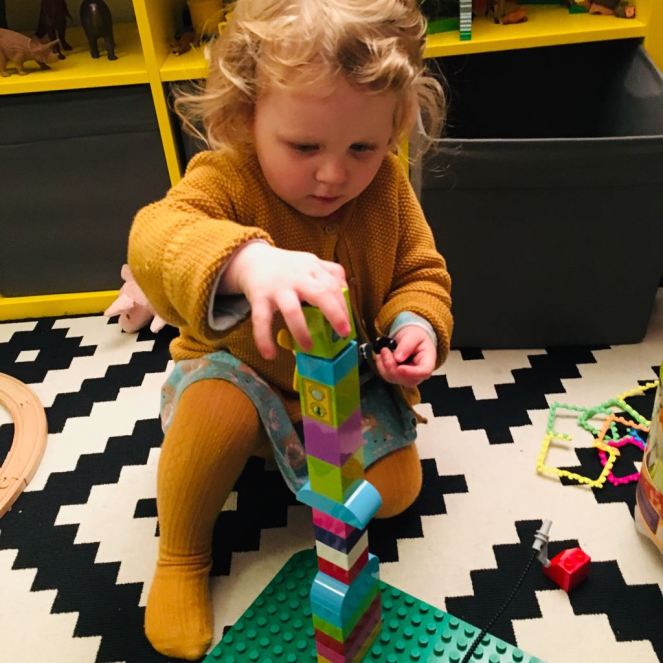Many parents and grandparents will have heard of STEM in the context of education, but will not know what to make of it, or how to encourage more STEM learning.
This is especially true if you’re caring for a child who is still in their preschool years.
In this blog I’ll unpack what STEM means in an early years context, and give you some ideas for fun and simple STEM activities.
STEM is an acronym that stands for: Science, Technology, Engineering, Maths.
STEM education is available in many schools and there is a growing movement towards introducing STEM into play and activities for preschool age children.

STEM activities can provide a natural pathway for a young child who is curious about the world around them, constantly seeking new information through their play.
Earlier this year, I was impressed to find that a STEM day nursery opened in our region!
The nursery covers all aspects of the Early Years Foundation Stage in its provision. But the focus is on exposing young children to STEM activities at a preschool age.
How does STEM work in Early Years
STEM can sound complex or intimidating to approach with a young child to approach, but that need not be the case!
In the context of Early Years learning, this is how STEM breaks down:
Science is an understanding of the world around the child. They are exploring, asking questions, and making predictions, such as what happens if …
Technology concerns the scientific tools and equipment that are available for the child to use to solve problems
Engineering is a creative approach to experimenting and finding ways to solve the problem
Maths means more than numbers and counting. Shapes, sizes, sequences, volume and capacity all play into the topic.
The acronym STEM is created from these four words. The best Early Years STEM activities will combine all four aspects in creative play.
In my experience, it is this kind of hands-on learning that children really enjoy and engage with. They often remember details from the experience, which leads to increased knowledge and understanding.

Fun, easy STEM activity: transferring water
Recently I created a fun, simple STEM activity for my granddaughter, Daisy.
Outside in our back garden I placed a bowl of water on her builder’s tray, along with some jugs and empty containers, a few spoons and scoops, a funnel and pipettes. I placed two empty cups on her play table next the builder’s tray

I asked Daisy if she could help me to transfer some of the water from the bowl into each cup, using any of the equipment on the builder’s tray.
This is as far as I wanted to go in leading the activity. I hoped that Daisy could come up with some ideas to transfer water.
Then it was time to talk about what we could do, using any of the equipment spread out on the builder’s tray.
Talking and sharing ideas brought in Daisy’s scientific knowledge, which she had gained from all of her water playtimes. Regular water play sessions had given Daisy opportunities to use jugs and funnels, scoops and spoons.



She used to love playing with pipettes and developing her strength and squeezing skills (until she discovered in bathtime play with pipettes she could squirt us too!)
Our discussion was followed by Daisy testing out her ideas. There wasn’t a right or wrong way for Daisy to move the water.
We spent time exploring whether there were different ways of achieving the same result – there may be a quicker way, a less messy way! Then we tried them all out to see what worked the best.


I wondered if Daisy might use the funnel to try and transfer the water directly to the cups.
I was surprised when instead she decided to place the funnel straight on top of one of the cups. She realised that this made it easier and more effective to transfer water using the scoop or the spoon.
After this, she also decided to see how accurately she could pour the water from a greater distance, and she enjoyed using the jugs and scoop to accurately target each cup!


Problem solving and creativity
While writing this blog, I spotted a neighbour’s grandson making a ramp on the driveway next door and then riding his bike across the driveway and up the ramp.
Then he came off his bike and returned to the ramp to adjust the length of the plank before riding over the ramp again and checking the effect.
This was his very personal STEM activity. Younger children could enjoy a similar STEM activity by making a ramp for their small vehicles. Daisy certainly loves to race her cars against one another along the floor, following imaginary roads
Here are a couple of other ideas for STEM activities:
- Make a paper boat for a small Lego figure – then float them across a paddling pool. How is the boat affected by the passenger? How many Lego figures can the boat carry before it sinks? How does their placement affect the stability of the boat? What if you add a mini mast?


- Make a den indoors or outside – use a few familiar pieces of furniture, throws and cushions. What materials work best to ensure the den is stable?
Hopefully these few examples are beginning to show easy it is to give your child or grandchild a fun, early introduction to STEM.
Granny Smith says…
- In the short term, STEM activities can give children the enquiring skills to find out how, why and what if.
- In the long term, engagement in STEM activities can have effects as far-reaching as influencing children’s career opportunities.

